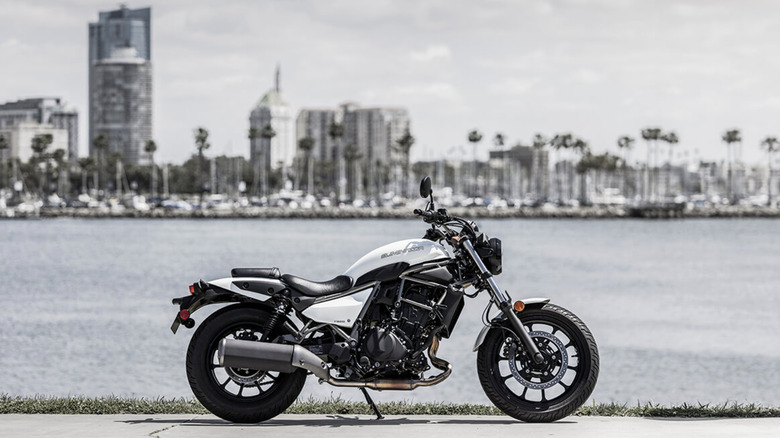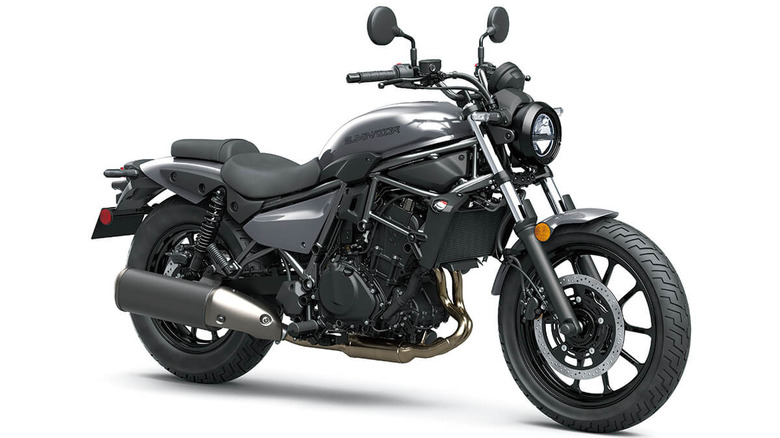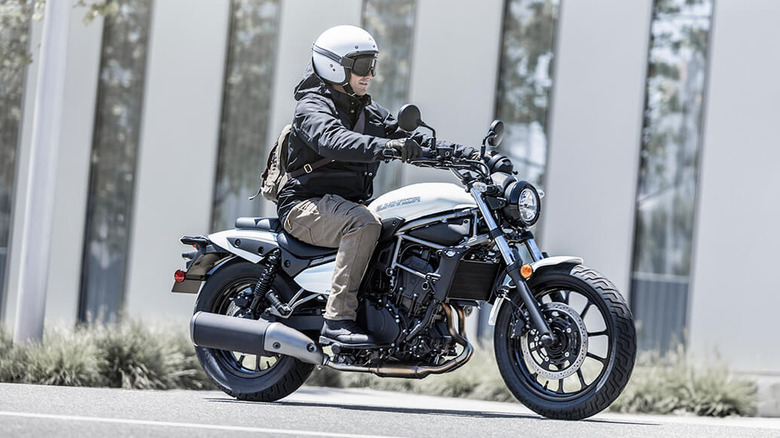Everything To Know About The 2024 Kawasaki Eliminator
The 2024 Eliminator is one of the most approachable, beginner-friendly bikes in Kawasaki's lineup. There are three versions of the Kawasaki Eliminator — the standard model which starts at $6,649, the Eliminator ABS (anti-lock brake system) model, which starts at $6,949, and the Eliminator SE ABS which starts at $7,249. While that might seem a bit steep for a beginner bike, it's pretty standard for the Eliminator's size.
The 2024 Eliminator is small enough to learn on, but powerful enough to not feel out-ridden in the first few months of ownership. And at 451cc, the Eliminator's closest cruiser competitor is the Honda Rebel 500 — a bike that checks in at 471cc. The Rebel 500 starts at $6,499 for the base model, with an additional $300 charge for ABS. The top-of-the-line Rebel 500 ABS SE model goes for $6,999. So, on base trim levels, it's a nearly-exact match, and only a couple of hundred dollars difference at the top of the range. But how does the Eliminator stack up, and what does it offer the money? Let's dive in.
The specs - how much power does the Eliminator have?
The Eliminator's engine is based on the Kawasaki Ninja 400's 399cc powertrain, but displacement has been increased. Powered by a 451cc parallel-twin engine, the Kawasaki Eliminator produces 31.7 lb-ft of torque — a decent number for the class. Kawasaki doesn't list a horsepower rating in the Eliminator's specs, but Cycleworld tested one on their dyno, and it put out 47.2 hp. That's certainly enough power for a bike that weighs in at just 388 pounds (curb weight for the Eliminator ABS). The Eliminator's fuel tank checks in at just 3.4 gallons (0.4 gallons more than the Rebel 500), which should be enough for most riders — provided you aren't planning any cross-country trips on your new Kawasaki.
Up front, the Eliminator boats an 18-inch wheel, with a 16-inch wheel at the rear, giving it a classic cruiser look. It has the same brakes as the Ninja 400, with 310mm rotors upfront and 220mm rotors at the rear. The seat height is a relatively low 28.9 inches, but the Honda Rebel 500's seat is lower at 27.2 inches. The Eliminator offers a "reduced reach" seat that has a narrow front and reduces the seat height by 0.78 inches (to a height of 28.12 inches), but it's still nearly an inch higher than the Honda's stock seat — and the reduced reach seat from Kawasaki will cost you an extra $240. Shorter riders will probably be more comfortable on the Honda.
What comes standard on the Eliminator?
While the Eliminator is, for the most part, approachable for beginner riders, it's certainly more expensive than the true entry-level 300cc bikes for new riders. And for the extra cost, you should expect a bit of added equipment. The base Eliminator comes with a single LED headlight, twin rear shocks, a digital tachometer and gear position indicator, and Bluetooth phone connectivity with the Rideology App — a decent list of standard equipment, although the app has almost universally negative reviews with an average rating of 1.8 on Google Play. Upgrading to ABS will cost you an extra $300, but Eliminator SE ABS adds even more gear.
An exclusive paint color, an upgraded seat, a headlight cowl, front suspension fork covers, and a waterproof USB-C outlet are all included on the SE ABS. It's not bad when you consider that it's only $300 more than the ABS model. Additional accessories are available for all three trim levels of the Eliminator, including frame sliders ($260.95), a passenger grab bar ($155.95), and a rear luggage carrier ($106.95). Even without the accessories, the 2024 Kawasaki Eliminator is an appealing bike with an appropriate price for the segment.


